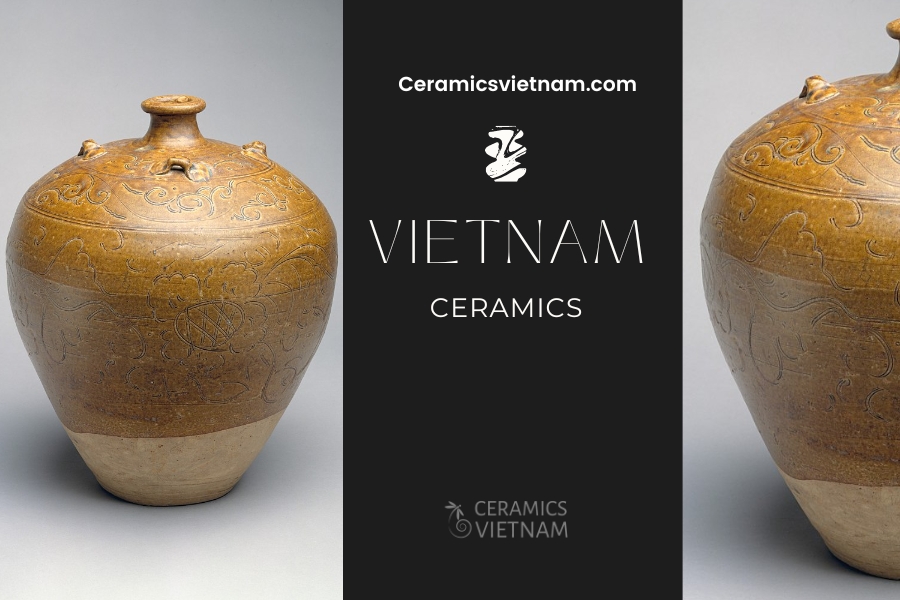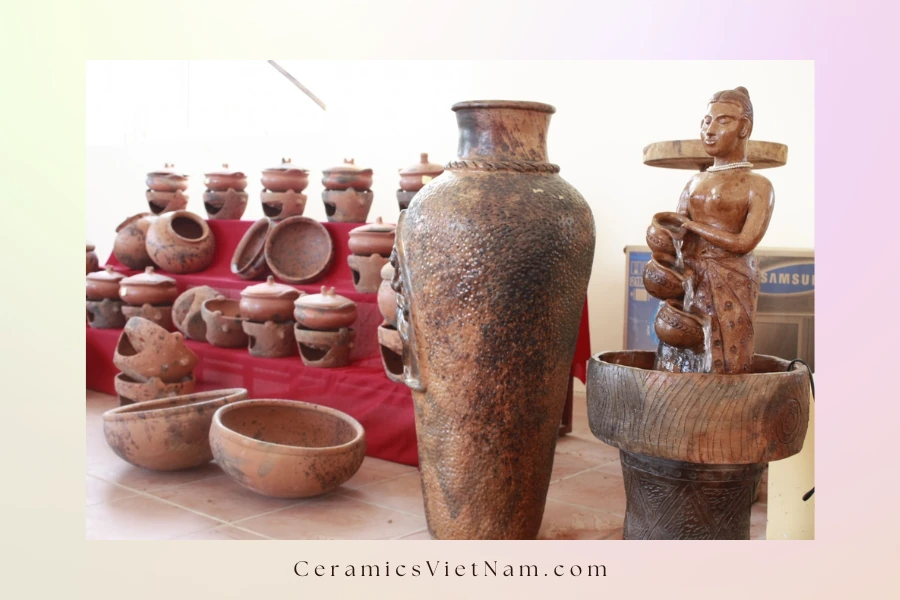Binh Duc Village, located in Phan Hiep commune, Bac Binh district, Binh Thuan province, is a renowned traditional craft village deeply intertwined with the life, customs, and traditions of the local Cham people. This craft has been passed down through generations, with women taking charge of most stages in the pottery-making process, including pounding, fermenting, clay mixing, wet product molding, pottery drying, shaping adjustments, and pre-firing polishing. The more labor-intensive tasks, such as transporting raw materials and firing pottery, are handled by men.
Introduction

Ceramic craftsmanship without a pottery wheel in Binh Thuan is truly unique
Binh Thuan, a province located in the southeastern part of Vietnam, boasts a rich cultural heritage and a vibrant artistic scene. The region is renowned for its diverse landscapes, ranging from pristine beaches to rolling sand dunes and lush mountains.
Brief Overview of Binh Thuan
Binh Thuan, with its capital in Phan Thiet, is characterized by a harmonious blend of tradition and modernity. As one of Vietnam’s coastal provinces, it plays a crucial role in the country’s economic and cultural tapestry. The province is not only a popular tourist destination but also a hub of traditional craftsmanship, with its artisans contributing significantly to the local identity.
Significance of Ceramic Craftsmanship in the Region
Among the various traditional crafts in Binh Thuan, ceramic craftsmanship holds a special place. The art of ceramics has been a cultural cornerstone, reflecting the historical and artistic essence of the region. The intricate designs and unique styles of Binh Thuan ceramics contribute to the province’s cultural distinctiveness.
Ceramic craftsmanship in Binh Thuan serves as a testament to the skills and creativity of its artisans, who have honed their craft over generations. The significance of ceramics extends beyond its aesthetic appeal; it plays a vital role in preserving the cultural heritage and identity of the local community.
History of Cham pottery
The uniqueness of Cham pottery lies in the preservation of traditional techniques and manual methods that have been passed down through ancient times. From clay extraction, processing, clay mixing, product molding, shaping adjustments, and polishing to the pottery firing process and the application of colored decoration after firing, artisans continue to follow traditional manual methods taught from generation to generation.
The hand-building technique in Binh Duc does not involve a pottery wheel; instead, it relies on the skilled and clever hands of artisans, accompanied by graceful foot movements around the fixed table of Cham women. This transforms loose clay into exceptionally delicate products. This method of pottery making dates back to the early stages of human civilization, thousands of years ago. Despite the antiquity of the technique, most potters worldwide have transitioned to more modern methods involving pottery wheels.
Creating Cham pottery from clay is a multi-stage process requiring experienced artisans with high craftsmanship, meticulousness, and patience. Despite using rudimentary tools, the handmade Cham pottery products showcase a traditional beauty that deserves appreciation, preservation, and development. Cham Binh Duc pottery products, though rooted in ancient techniques, are diverse, ranging from cooking utensils like pots and kettles to storage items such as jars, bowls, and trays.
In contemporary times, alongside producing diverse and convenient products for daily life, traditional Cham pottery plays a special role in culinary culture. Cham Binh Duc pottery is present in many restaurants, hotels, and households, contributing to making dishes both delicious and visually appealing. Many believe that using Cham Binh Duc pottery products for cooking enhances the taste compared to aluminum or stainless-steel utensils.
Moreover, the traditional pottery craft of the Cham people serves as a unique resource for local tourism development, contributing to the economic and social benefits of the region. Recently, Binh Thuan province approved a project to conserve and develop the traditional pottery craft of the Cham people in Binh Duc hamlet, Phan Hiep commune, Bac Binh district, transforming Cham Binh Duc pottery village into an attractive destination for domestic and international tourists.
According to the project, Binh Thuan will establish a showroom displaying pottery products, combined with artistic performances of pottery making, firing, and traditional Cham folk arts and dances to serve tourists. The province will develop and promote tourism tours for visitors to explore and experience the Cham Binh Duc pottery village. The Department of Culture, Sports, and Tourism of Binh Thuan will intensify propaganda efforts and showcase pottery products by participating in fairs, exhibitions, and tourism events.
Binh Thuan province plans to open training courses to impart skills to the local young generation, bring artisans to Cham pottery villages in Ninh Thuan to learn decoration methods and pottery techniques for decorative purposes and souvenir production. This aims to enhance product quality, diversify products, meet the preferences and demands of tourists and the market, and contribute to the overall development of Cham pottery craftsmanship.
Contemporary relevance and challenges

Ceramic craftsmanship without a pottery wheel in Binh Thuan is truly unique
The Role of Binh Thuan Ceramics in the Modern Era
In the modern era, Binh Thuan ceramics continue to play a significant role in shaping the cultural and artistic landscape of the region. While traditional craftsmanship remains valued, contemporary artisans are adapting their techniques to meet the demands of a changing world. Binh Thuan ceramics are not only cherished locally but have gained recognition on the national and international stages, contributing to the province’s cultural diplomacy.
Economic Impact and Market Trends
The economic impact of Binh Thuan ceramics extends beyond its cultural significance. The craft has become a source of livelihood for many local artisans and entrepreneurs. The ceramics industry contributes to the region’s economic development by attracting tourists, generating income, and participating in the broader market trends. As consumer preferences evolve, Binh Thuan ceramics have adapted, incorporating modern designs and meeting international standards to remain competitive in the global market.
Preservation Challenges and Efforts
However, the preservation of Binh Thuan ceramics faces several challenges in the face of rapid modernization. Urbanization and changes in lifestyle pose a threat to traditional crafting practices. Additionally, the influx of mass-produced ceramics may overshadow the uniqueness of handmade Binh Thuan ceramics.
Efforts to preserve this cultural heritage include initiatives aimed at raising awareness, documenting traditional techniques, and providing support for local artisans. Collaborations between governmental bodies, non-profit organizations, and the private sector are crucial to sustaining Binh Thuan ceramics in the face of contemporary challenges. Striking a balance between preserving tradition and embracing innovation is key to ensuring the continued vibrancy and relevance of this cherished craft.














Leave a reply